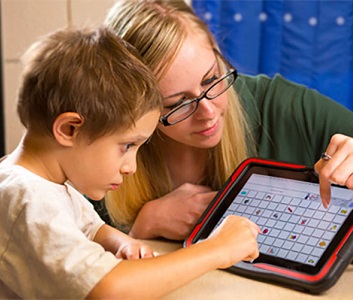Articles
Alternative Means of Communication
By Kathleen Wentland, MA, CCC-SLP
Speech Language Pathologist
What does alternative means of communication mean?
There are many ways to communicate besides speaking. Alternative means of  communication are other ways to communicate that do not involve spoken speech. In this day and age of technology, texting is a common means of communicating that does not involve speaking. Using gestures, writing, body language, sign language and facial expression are also ways we communicate. When someone has difficulty speaking or is unable to speak, they may rely on another way to communicate.
communication are other ways to communicate that do not involve spoken speech. In this day and age of technology, texting is a common means of communicating that does not involve speaking. Using gestures, writing, body language, sign language and facial expression are also ways we communicate. When someone has difficulty speaking or is unable to speak, they may rely on another way to communicate.
What are communication devices?
Communication devices can be low or high technology. Examples of low technology communication methods include a communication board with words, pictures and/or letters. A person points to these words or pictures to communicate what they want. For example if someone is thirsty they can point to a picture of a glass of water. By pointing to words and pictures someone can convey what they need without speaking. If a person can spell, they can use an alphabet board to spell a message (just like using a keyboard when texting). High technology communication devices are computers that have voice output. When someone selects a word, picture or phrase the computer says it out loud. An advantage of these high technology devices is that they can be connected to the internet so people can communicate in social media like Facebook and through email. If someone has weakness in their hands and they are unable to point to the words or pictures, they can use a communication device with eye gaze or a head mouse. For eye gaze the person looks at the picture or word rather than pointing with their hands. For the head mouse a person has a dot placed on their forehead or glasses and they can pick the word or picture by moving their head. The devices are personalized to include family members' names and even include photographs of family and friends, places they like to visit etc.
Who uses a communication device?
Both children and adults can use a communication device. Adults who have diseases that affect nerves and muscles such as ALS (Amyotrophic Lateral Sclerosis) can develop speech that is not clear. Stroke patients can also have speech and language problems which make it difficult for them to talk. Children who have difficulty developing spoken speech may also benefit from a communication device. By using these devices children can also develop language skills.
What type of communication device does a person need?
A team of individuals is necessary to evaluate an adult or child's ability to use a communication device. A speech language pathologist typically evaluates the speech and language skills to determine the most appropriate device for an individual. An occupational therapist will assess motor skills and hand function to determine the best way an individual will select words and/or pictures on the device. A physical therapist assesses the person's posture and positioning for the most optimal use of the device.
How do I communicate with someone who uses a communication device?
Speech language pathologists provide training and support to the individual and their family during the evaluation period and after a person gets their device. It is really important that the environment supports the person who is using a communication device. Allow the person to start a conversation using their device, give them enough time to create their messages and make sure they get a turn in conversations especially in group situations. Being patient and making eye contact with persons using a communication device will help them feel connected to others and greatly improve their quality of life.


